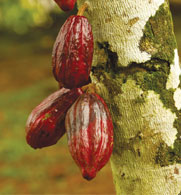 years cocoa powder has driven the cocoa market, rising to historic highs in 2011, in part due to the global economic slowdown that created strong demand for (then) lower-priced powder over traditionally higher-priced cocoa butter. But the market appears to have returned to its more traditional scenario with cocoa butter in the driver’s seat and cocoa powder fading somewhat into the background.
years cocoa powder has driven the cocoa market, rising to historic highs in 2011, in part due to the global economic slowdown that created strong demand for (then) lower-priced powder over traditionally higher-priced cocoa butter. But the market appears to have returned to its more traditional scenario with cocoa butter in the driver’s seat and cocoa powder fading somewhat into the background.To set the stage, when the global economy sank in 2008, demand for higher-price chocolate products, which use cocoa butter, fell, especially in Europe, which has the highest per capita chocolate consumption in the world. There was a time when cocoa beans were processed for the butter and powder was almost a byproduct, with processors selling it for what they could get, although that hasn’t been the case for many years. Prices for the basic 10% to 12% natural cocoa powder began 2008 around 60c a lb (up 50% from lows around 40c in early 2006), and by May 2011 had soared more than six times to over $2.50 a lb. During that time, butter stocks sat in warehouses while some confectioners and other food manufacturers reformulated recipes to use powder, in some cases switching to “compounds” that utilized cocoa powder and vegetable oil rather than cocoa butter.
But as the saying goes, the best cure for high prices is high prices. Since May 2011, cocoa powder values have plunged to lows around 90c a lb, which still is strong on a historical basis but is down more than 60% from two years ago.
Meanwhile, the cocoa butterfat ratio, which is used to price cocoa butter against cocoa bean futures prices as actual butter values are difficult to ascertain, has understandably moved in the opposite direction as powder. The butterfat ratio currently is at a five-year high near 3.0 (3 times the New York cocoa bean futures price of $2,630 a tonne, which puts butter near $7,900 a tonne), with some sources putting cocoa butter prices at eight-year highs in the United States. The ratio was near 1.4 in May 2011 (when powder prices peaked), dropped below 1.0 in May 2012 and climbed over 2.0 in May 2013.
Improving economies and increasing demand for chocolate have been credited with boosting cocoa butter prices. Traders suggested some processors may tweak operations to focus on butter production over powder. For example, when butter is cheap and powder is high, processors will “squeeze” less butter out of the bean, leaving closer to 12% butter in the basic 10% to 12% cocoa powder grade. When powder is cheap and butter is high, like now, processors will lower the butterfat component closer to 10%, still within the allowable range but providing removing more butter from the powder so the butter may be sold separately.
There also is talk that there may be some food manufacturers again moving away from cocoa butter due to high prices and beginning to use compounds, where applications allow (compounds would have less of a “buttery” mouthfeel). But that shift has yet to be seen in powder demand. Many users have covered powder needs through mid-2014, but bookings beyond that time have recently slowed, even though prices are near four-year lows and sellers see more upside than downside potential in the months ahead.
Nearby cocoa bean futures prices in New York also have been on an uptrend, trading at one-year highs above $2,600 a tonne and at a slight inverse to deferred contracts. Futures prices still are well below recent highs above $3,600 a tonne set in February 2011.
Futures prices have been supported by ideas of increased demand coupled with concerns about the new crop in West Africa, which accounts for about 70% of the world’s cocoa bean supply and where the 2013-14 main crop harvest is just getting under way. Demand typically has been hard to quantify, much less forecast, but strong quarterly cocoa grind figures in Europe and North America suggest demand is on the upswing. Some in the trade also suggest a large speculative fund presence, accounting for about 45% of open interest, has given support to cocoa bean futures prices.
While not directly affecting the cocoa market, another key development that appears to be nearing culmination is the purchase by Cargill of the cocoa operations of Archer Daniels Midland Co. If approved, the acquisition will result in two companies accounting for an estimated 40% to 50% of the world’s cocoa grinding capacity. The other company is Switzerland-based Barry Callebaut, which earlier in the year boosted its global scope with the purchase of the cocoa division of Petra Foods. The recent and upcoming mergers will make navigating the global cocoa market even more interesting for other processors as well as buyers.





